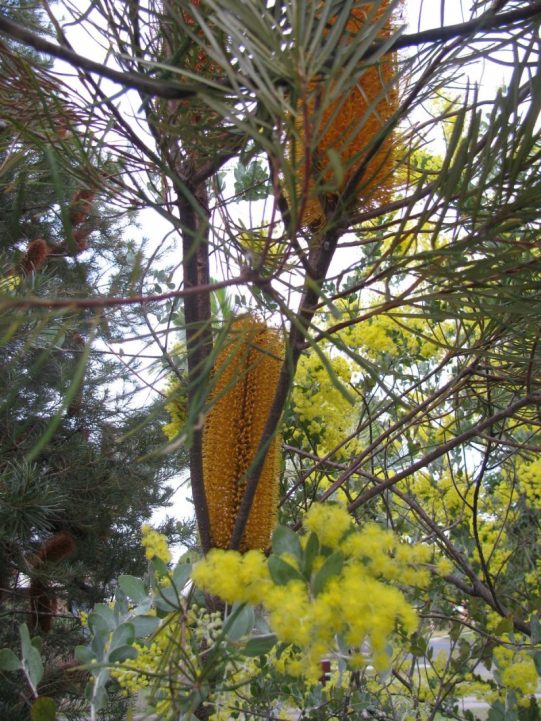Winter is a beautiful time of year here in the sub tropics of Australia. The nights are cool and brisk, but the days are sunny, clear, and warm (about mid twenties in Celsius degrees).
I love this time of year, no humidity and it often feels like we have skipped winter, and gone from Autumn directly to spring. This is my morning view.

At least when I look out my window, I see the beautiful specimens of Wattle (Acacia species) and Banksia (Giant Candles).
Banksia plants come in many varieties and were named about the Botanist on board Cook’s ship the Endeavour when it discovered the East coast of Australia in 1770. Banks and his colleagues made many drawings on these glorious plants, and thus were named after him.

Banksia have an interesting adaptation to the harsh Australian climate. They do not have flowers, but instead a large cone that holds nectar (food for the many Lorikeets and nectar feeding birds). Following this, the cone develops into a seed pod, protecting the valuable seed within until it is one day exposed to high intensity heat (such as found in a bush fire).
Upon being burnt, the seed cone will open, releasing the seed contained within. The Banksia plant is then free to germinate in not only a potash rich soil, but in an area with very little competition from other plants for sun and moisture.

Wattle blossoms
Australia’s official national floral emblem, featured on the coat-of-arms. Possibly the best known amongst the Australian plants. With 600 or more kinds of wattles, they can be found in every part of the country, from well-watered areas to the arid Centre to the cold mountain regions.
The wattles are usually the first to appear after bush-fires and can be found growing in the most remote areas, from low, spreading shrubs to large, upright growing trees. The individual flowers are always very small and massed together in pom-pom heads or rod-like spikes. Whilst most wattles are spring-flowering, there are some that bloom all year round.
1st September is Australia’s Wattle Day.
WATTLE
Wattles belong to the genus Acacia, in the Mimosa family.
There are over 600 different species distributed throughout Australia with shapes varying from low, spreading shrubs to large, upright trees. It is often called ‘Mulga’. Whilst most are early spring and summer-flowering, there are wattles that bloom all year round.
Which is really clever and definitely something to ponder about: the resilience and endless adaptation of nature.


